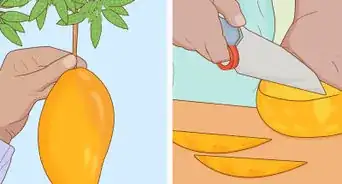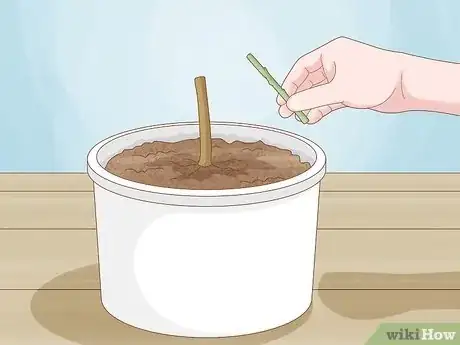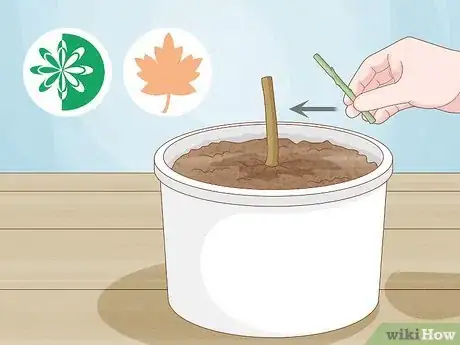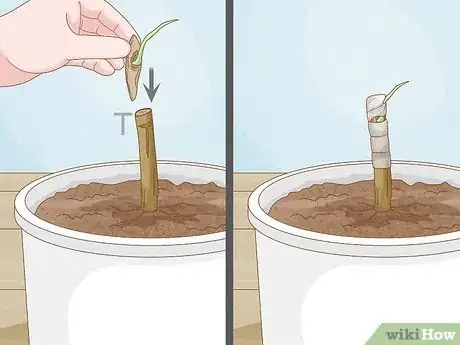This article was co-authored by wikiHow Staff. Our trained team of editors and researchers validate articles for accuracy and comprehensiveness. wikiHow's Content Management Team carefully monitors the work from our editorial staff to ensure that each article is backed by trusted research and meets our high quality standards.
There are 11 references cited in this article, which can be found at the bottom of the page.
This article has been viewed 30,355 times.
Learn more...
Avocados are pretty magical by themselves. Their beautiful, tasty fruit is adapted to attract giant sloths, but the tree has somehow survived the sloths skipping their lunch dates for the last 13,000 years.[1] X Research source But getting these magical fruit to show up takes some extra magic that only humans have invented: grafting two plants together to make one. Grafting is never 100% guaranteed, but it gets easier with practice and you can easily try it at home with basic supplies.
Steps
What is grafting?
-
Grafting is the process of combining multiple plants into one. Have you ever seen two trees in a forest that grew into each other and now share the same trunk? Grafting is a more intentional way of achieving that result. By choosing one avocado plant that grows strong and healthy, and grafting on a second plant that makes good-tasting avocados, you can get the best of both varieties. It takes precision and a bit of luck to get the new grafted plant to grow together and survive, but you can practice this in a home garden with minimal tools.
Which avocado varieties can you graft together?
-
Use a hardy rootstock and a scion with good fruit. There are a huge number of varieties, and no universal best option.[2] X Trustworthy Source University of California Division of Agriculture and Natural Resources Extension program of the University of California system devoted to educating and improving local communities Go to source You can ask for local advice from a nearby university extension or plant nursery, but here are the basics:
- The rootstock is the avocado plant that provides the roots and lower trunk. Choose a variety that grows well locally, so it is resistant to local disease and adapted to your soil.[3] X Research source Varieties with large seeds are usually best.[4] X Research source
- The scion is the piece of an avocado plant that you'll graft onto the rootstock. Choose this for its high-quality fruit. You can take a bud or branch from an existing tree, or buy special scion wood or seedlings. (Growing it from a normal avocado pit usually won't work.)
- Just about any two varieties will join together. Some combinations don't make healthy plants, but it's not a big risk for a home garden.[5] X Research source
When in the year can you graft an avocado plant?
-
Spring or fall are the best options. The easiest grafting method (attaching a single bud) only works when the outer bark "slips," peeling easily off without tearing. For avocados, this means spring or fall. Ideally, do this when there are a few weeks of warm weather coming up.[6] X Research source
- You have a longer window of "slipping" time if the plant gets plenty of water. Super hot or cold weather can end the slipping early, so if that happens, get your grafting tools out![7] X Research source
- Grafting wood instead? Spring or fall is still usually the best option.[8] X Research source Finding the perfect time for these can be super tricky, and depends on the graft method and even the individual tree. Get an experienced grafter to help you, or choose the moment when you see fat buds with a healthy green color.[9] X Research source
When is an avocado seedling ready to accept a graft?
-
Wait until it is at least 24 inches (61 cm) tall. If you want to play it safe, let it reach 30 inches (76 cm).[10] X Research source This usually takes three to four months after planting a young seedling, or four to five months after growing it from a pit.[11] X Research source
What tools do you need to graft avocado plants?
-
All you need is a sharp, sanitized knife and a way to bind the trees. You can find this equipment at a gardening supply store, or improvise with kitchen tools:[12] X Research source
- An extra- sharp knife
- Alcohol disinfectant (70%+) or any other disinfection method to use on the knife before you begin
- Grafting tape, budding strips, or flagging tape (or a cut rubber band as a last resort, but this isn't great for budding or any outdoor graft)
- Cling film (optional)—ideally "Parafilm," but normal PVC cling wrap also works.[13] X Research source
What is the easiest way to graft avocados?
-
Cut a "T" shape through the bark and insert a single bud. You can do this on a rootstock seedling at a bud-free spot about 8–12 inches (20–30 cm) above the ground. It also works on a sapling or full-grown tree—just pick a spot on the trunk or a branch that's 1⁄4–1 inch (0.64–2.54 cm) in diameter.[14] X Research source
- Make the "T" shape with a vertical slit about 1 inch (2.5 cm) tall and a horizontal slit about 1/3 the way around the seedling (or branch). Gently twist the knife to separate the flaps of bark.[15] X Research source Avoid touching the cut surface with your fingers.[16] X Research source
- Cut a fat, green bud off the other plant.[17] X Research source Cut in a "shield" shape, with a point about 1⁄2 inch (1.3 cm) below the bud and a horizontal cut about 3⁄4 inch (1.9 cm) above it, deep enough to get wood as well as bark. Gently peel this off the tree, touching only the outer bark side.[18] X Research source
- Slide the "shield" into the T cut from above until the top lines up with the top of the "T." Keep the flaps of the T-cut over the "shield" with the bud poking out between them.[19] X Research source
Can you graft on a whole avocado shoot?
-
This is harder than budding, but gives the new branch a headstart. Buy or cut off a scion shoot that's mature (not rubbery), with fat green buds.[20] X Research source Cut off about 4–6 inches (10–15 cm), with at least three buds, and strip off the leaves.[21] X Research source The best way to attach this depends on the size of your rootstock (which usually works best when it's the same size across as the scion):
- Small rootstocks (up to 1⁄4 inch (0.64 cm) across), "wedge graft": Shape the base of the scion into a wedge with two 30º angles.[22] X Research source Cut the rootstock horizontally, then cut a groove down through the center of the cut, a little deeper than the scion wedge. Fit the wedge firmly into the groove until the edges are flush.[23] X Research source
- Medium rootstocks (1⁄4–1⁄2 inch (0.64–1.27 cm) across), "whip-and-tongue graft": Cut both the rootstock seedling and the base of the scion in matching, long slants, about 2 inches (5.1 cm) long. Cut a groove down through the center of both cuts, then fit the pieces together so the grooves lock and the edges are flush.[24] X Research source
How do you graft onto a large tree or branch?
-
Insert new shoots into the bark of cut trunks or branches. Cut off the existing tree just above a crotch. Cut vertical slits about 3 inches (7.6 cm) deep through the bark around the edge of the cut, spacing the cuts about 3–5 inches (7.6–12.7 cm) apart. For each slit, take a mature scion shoot with 4 to 6 buds on it, and cut its base with a sloping cut so the cut surface matches the length of the slit. Lift the bark on one side of the slit with a knife, push the scion in place, and fit it snugly together so the living cambium layer between the bark and the wood line up on the two pieces.[25] X Research source
- These are harder to secure in place than other grafted scions. You can attach them with thin flathead nails or tie them on with a strong cord. Grafting wax or pruning paint over the whole cut area helps protect it.[26] X Research source
- If you can, leave one "nurse branch" above the cut on the rootstock. This protects the new graft. You can prune away the nurse branch once the graft is healed.
How do you wrap the graft after attaching it?
-
Wrap tightly but keep the bud uncovered. Wind grafting tape, budding rubber, or flagging tape around the whole graft to keep the flaps of bark tightly together. If you're "T-budding," let the new bud poke out in between. If the tape doesn't stick to itself, just tie the ends or tuck them underneath the windings.[27] X Research source
- For best results, follow up with Parafilm or PVC cling film around the whole area (including the bud if T-budding). This keeps moisture in to help the graft grow together.[28] X Research source
- Transparent grafting tape and cling film can overheat the plant. If you're using them, keep the graft join out of direct sun or paint these materials white.[29] X Research source
How long does it take for an avocado graft to heal together?
-
Avocado grafts heal in 3 to 8 weeks. Be patient with your beautiful new Frankenstein's monster of a plant—messing with the graft too early is more likely to damage it than to help. A T-bud graft takes about 3–4 weeks to heal together and begin new growth in spring, or 6–8 weeks in fall.[30] X Research source Larger grafts are pretty similar, usually taking about 4 to 6 weeks.[31] X Research source
Is there anything you need to do once the bud starts to grow?
-
Finish with a little pruning and congratulate yourself. Well done! The last step is to prune away the top of the rootstock, so the plant doesn't waste energy growing the wrong fruit. (If you used a "wedge graft," the rootstock top is already gone and you can skip this.) Do this in two stages:[32] X Research source
- First, use a disinfected knife to cut the seedling (or branch) about 13 inches (33 cm) above the graft. The part that's left is the "nurse branch" that helps protect the new scion.
- Wait until your scion has grown a few new leaves, then remove the nurse branch right down to 1⁄8 inch (3.2 mm) above the graft.
- If you grafted multiple scions onto one large branch or trunk, check and see which one looks largest and healthiest. Prune the others back to slow them down, then cut them off completely once the main scion is big and healthy.[33] X Research source
- You can also remove any wrappings that are left once you're sure the graft is firm and growing. Grafting tape and Parafilm slowly degrade on their own, so you can leave those on. (Leaving the tape on too long is only an issue if the tree is growing rapidly.)
How long does it take for a grafted avocado to bear fruit?
-
A grafted tree typically takes three or four years to fruit. You've got a while to wait, but that's a lot better than the 10+ years some seed-grown trees can take (if they end up fertile at all).[34] X Research source
You Might Also Like











References
- ↑ https://www.smithsonianmag.com/arts-culture/why-the-avocado-should-have-gone-the-way-of-the-dodo-4976527/
- ↑ https://ucanr.edu/blogs/blogcore/postdetail.cfm?postnum=21125
- ↑ http://www.avocadosource.com/journals/horticulturalreviews/hortrev_1995_pg_381-429.pdf
- ↑ https://www.ctahr.hawaii.edu/oc/freepubs/pdf/F_N-49.pdf
- ↑ http://www.avocadosource.com/Journals/CA/CA_1955_V9_N2_PG_11_12.pdf
- ↑ http://homeorchard.ucdavis.edu/8001.pdf
- ↑ https://content.ces.ncsu.edu/grafting-and-budding-nursery-crop-plants
- ↑ http://homeorchard.ucdavis.edu/8001.pdf
- ↑ http://www.avocadosource.com/papers/research_articles/whitsellrh1989.pdf
- ↑ http://homeorchard.ucdavis.edu/8001.pdf
- ↑ https://www.ctahr.hawaii.edu/oc/freepubs/pdf/F_N-51.pdf
- ↑ http://www.avocadosource.com/papers/research_articles/whitsellrh1989.pdf
- ↑ https://www.scielo.br/scielo.php?pid=S0100-204X2000001000009&script=sci_abstract
- ↑ http://homeorchard.ucdavis.edu/8001.pdf
- ↑ http://homeorchard.ucdavis.edu/8001.pdf
- ↑ https://content.ces.ncsu.edu/grafting-and-budding-nursery-crop-plants
- ↑ http://www.avocadosource.com/papers/research_articles/whitsellrh1989.pdf
- ↑ http://homeorchard.ucdavis.edu/8001.pdf
- ↑ http://homeorchard.ucdavis.edu/8001.pdf
- ↑ https://www.ctahr.hawaii.edu/oc/freepubs/pdf/F_N-51.pdf
- ↑ https://www.ctahr.hawaii.edu/oc/freepubs/pdf/F_N-51.pdf
- ↑ https://www.ctahr.hawaii.edu/oc/freepubs/pdf/F_N-51.pdf
- ↑ http://www.avocadosource.com/papers/research_articles/whitsellrh1989.pdf
- ↑ http://homeorchard.ucdavis.edu/8001.pdf
- ↑ http://homeorchard.ucdavis.edu/8001.pdf
- ↑ http://homeorchard.ucdavis.edu/8001.pdf
- ↑ https://content.ces.ncsu.edu/grafting-and-budding-nursery-crop-plants
- ↑ http://www.avocadosource.com/papers/research_articles/whitsellrh1989.pdf
- ↑ http://www.avocadosource.com/papers/research_articles/whitsellrh1989.pdf
- ↑ http://homeorchard.ucdavis.edu/8001.pdf
- ↑ https://www.ctahr.hawaii.edu/oc/freepubs/pdf/F_N-51.pdf
- ↑ http://homeorchard.ucdavis.edu/8001.pdf
- ↑ http://homeorchard.ucdavis.edu/8001.pdf
- ↑ https://deepgreenpermaculture.com/2017/02/16/the-difference-between-seedling-grafted-and-cutting-grown-fruit-trees/
- ↑ http://www.avocadosource.com/papers/research_articles/whitsellrh1989.pdf
- ↑ http://www.avocadosource.com/papers/research_articles/whitsellrh1989.pdf
About This Article

























































